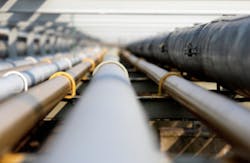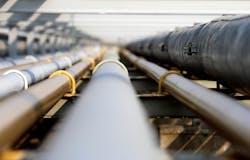Egypt plays a vital role in international energy markets through the operation of the Suez Canal and Suez-Mediterranean (Sumed) Pipeline, according to a report by the U.S. Energy Information Administration. In 2012, about 7 percent of all seaborne traded oil and 13 percent of liquefied natural gas (LNG) traded worldwide transited through the Suez Canal. Egypt's 2011 revolution and the unrest that has followed have not had any noticeable effect on oil and LNG transit flows through the Suez Canal or Sumed Pipeline.
The Suez Canal is an important transit route for oil and LNG shipments traveling northbound from the Persian Gulf to Europe and North America and southbound from North Africa and countries along the Mediterranean Sea to Asia. Changes to total oil and LNG flows through the Suez Canal in 2012 mainly occurred because of events outside of Egypt, particularly the restart of Libyan oil production and changing dynamics in LNG markets. Further, the Sumed Pipeline is the only alternative route nearby to transport crude oil northbound if loaded tankers are too large or ride too low in the water to navigate through the Suez Canal.
RELATED: Developing Countries Drive New Refinery Projects
Oil Flows
In 2012, southbound oil flows reached a record high as Libyan oil shipments through the Suez Canal quadrupled in 2012 compared with the previous year, reflecting the ramp-up of Libyan oil production after its civil war. In 2012, about 2.97 million barrels per day (bbl/d) of total oil (crude oil and refined products) transited the Suez Canal in both directions. This is the highest amount ever shipped through the Suez Canal, and made up about 7 percent of total seaborne traded oil. Crude oil flows through Sumed decreased in 2012 to 1.54 million bbl/d, as more crude oil was shipped through the Suez Canal via tankers.
LNG Flows
Total Suez LNG flows as a percentage of total LNG traded worldwide fell to 13 percent, or 1.5 trillion cubic feet, in 2012, compared with 18 percent in 2011 for two main reasons. First, northbound LNG flows through the Suez Canal fell by nearly one-third in 2012 largely because of decreased LNG exports from Qatar to the U.S. and Europe. Second, northbound flows also fell because of reduced LNG exports from Yemen as a result of sabotage attacks on a gas pipeline.
Supply Chain
Although external factors have to this point played a larger role in altering hydrocarbon flows through Egypt's transit points, unrest in Egypt still presents a risk, and the Egyptian army continues to guard the Suez Canal. Closure of the Suez Canal and the Sumed Pipeline would necessitate diverting oil tankers around the southern tip of Africa, the Cape of Good Hope. That would add 2,700 miles to ship oil from Saudi Arabia to the U.S., increasing both costs and shipping time, according to the U.S. Department of Transportation. Moreover, shipping around Africa would add 15 days of transit to Europe and 8-10 days to the U.S., according to the International Energy Agency.
Oil & Natural Gas Production
Egypt's oil and gas production has largely been unaffected by the social unrest. The most visible effect of the revolution on Egypt's energy sector has been a series of attacks on the Arab Gas Pipeline that contributed to a significant drop in the country's pipeline gas exports. In addition, growing local demand for oil and gas amid stagnant production has led to energy shortages, contributing to continued protests and sporadic unrest in the country.



